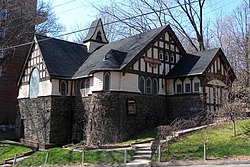Spuyten Duyvil, Bronx
| Spuyten Duyvil | |
|---|---|
| Neighborhood of the Bronx | |

Looking northwest at Edgehill Church of Spuyten Duyvil
|
|
| Location in New York City | |
| Coordinates: 40°52′52″N 73°55′02″W / 40.8812107°N 73.9173588°WCoordinates: 40°52′52″N 73°55′02″W / 40.8812107°N 73.9173588°W | |
| Country |
|
| State |
|
| City |
|
| Borough |
|
| Area | |
| • Total | 1.23 km2 (0.473 sq mi) |
| Population (2011) | |
| • Total | 10,279 |
| • Density | 8,400/km2 (22,000/sq mi) |
| Economics | |
| • Median income | $80,330 |
| ZIP codes | 10463, 10471 |
| Area code | 718, 347, 646 |
Spuyten Duyvil /ˈspaɪtən ˈdaɪvəl/ is an upper middle class neighborhood of the Bronx, New York City. It is bounded on the north by Riverdale, on the east by Kingsbridge, on the south by the Harlem River, and on the west by the Hudson River, although some consider it to be the southernmost part of Riverdale.
The area is named after Spuyten Duyvil Creek. "Spuyten Duyvil" may be literally translated as "Spouting Devil" or Spuitende Duivel in Dutch; a reference to the strong and wild tidal currents found at that location. It may also be translated as "Spewing Devil" or "Spinning Devil", or more loosely as "Devil's Whirlpool" or "Devil's Spate." Spui is a Dutch word involving outlets for water. Historian Reginald Pelham Bolton, however, argues that the phrase means "sprouting meadow", referring to a fresh-water spring.
An additional translation, "to spite the Devil" or "in spite of the devil", was popularized by a story in Washington Irving's A Knickerbocker's History of New York published in 1809. Set in the 17th Century, the story tells of trumpeter Anthony Van Corlaer summoned by Dutch colonial governor Peter Stuyvesant to warn settlers of a British invasion attempt, with Corlaer attempting to swim across the creek in treacherous conditions. The creek was referred to as Shorakapok by Lenape Native Americans in the area, translated as “the sitting down place” or “the place between the ridges”.
...
Wikipedia



